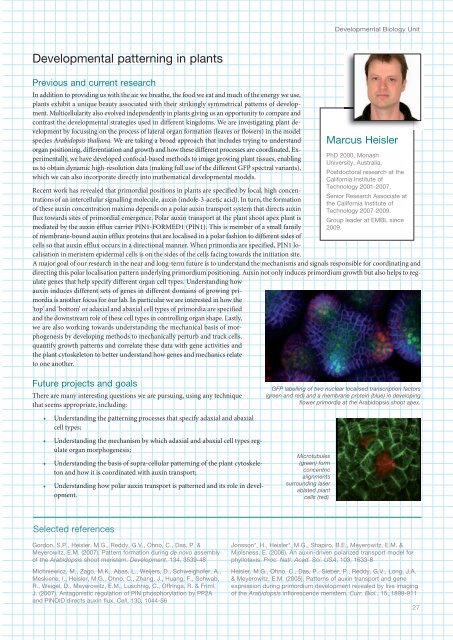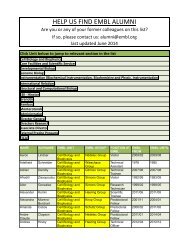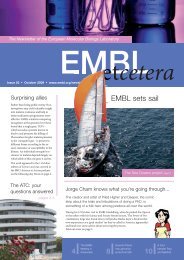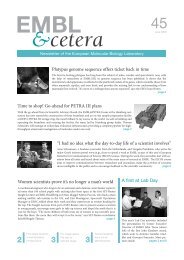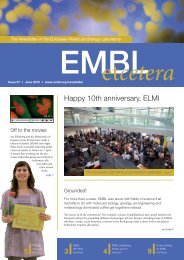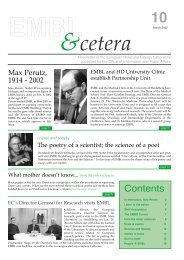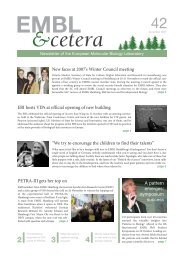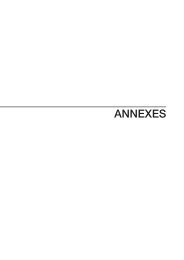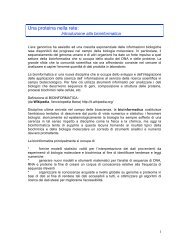ayout 1 - EMBL Grenoble
ayout 1 - EMBL Grenoble
ayout 1 - EMBL Grenoble
You also want an ePaper? Increase the reach of your titles
YUMPU automatically turns print PDFs into web optimized ePapers that Google loves.
Developmental Biology UnitDevelopmental patterning in plantsPrevious and current researchIn addition to providing us with the air we breathe, the food we eat and much of the energy we use,plants exhibit a unique beauty associated with their strikingly symmetrical patterns of development.Multicellularity also evolved independently in plants giving us an opportunity to compare andcontrast the developmental strategies used in different kingdoms. We are investigating plant developmentby focussing on the process of lateral organ formation (leaves or flowers) in the modelspecies Arabidopsis thaliana. We are taking a broad approach that includes trying to understandorgan positioning, differentiation and growth and how these different processes are coordinated. Experimentally,we have developed confocal-based methods to image growing plant tissues, enablingus to obtain dynamic high-resolution data (making full use of the different GFP spectral variants),which we can also incorporate directly into mathematical developmental models.Recent work has revealed that primordial positions in plants are specified by local, high concentrationsof an intercellular signalling molecule, auxin (indole-3-acetic acid). In turn, the formationof these auxin concentration maxima depends on a polar auxin transport system that directs auxinflux towards sites of primordial emergence. Polar auxin transport at the plant shoot apex plant ismediated by the auxin efflux carrier PIN1-FORMED1 (PIN1). This is member of a small familyof membrane-bound auxin efflux proteins that are localised in a polar fashion to different sides ofcells so that auxin efflux occurs in a directional manner. When primordia are specified, PIN1 localisationin meristem epidermal cells is on the sides of the cells facing towards the initiation site.A major goal of our research in the near and long-term future is to understand the mechanisms and signals responsible for coordinating anddirecting this polar localisation pattern underlying primordium positioning. Auxin not only induces primordium growth but also helps to regulategenes that help specify different organ cell types. Understanding howauxin induces different sets of genes in different domains of growing primordiais another focus for our lab. In particular we are interested in how the‘top’ and ‘bottom’ or adaxial and abaxial cell types of primordia are specifiedand the downstream role of these cell types in controlling organ shape. Lastly,we are also working towards understanding the mechanical basis of morphogenesisby developing methods to mechanically perturb and track cells,quantify growth patterns and correlate these data with gene activities andthe plant cytoskeleton to better understand how genes and mechanics relateto one another.Future projects and goalsThere are many interesting questions we are pursuing, using any techniquethat seems appropriate, including:• Understanding the patterning processes that specify adaxial and abaxialcell types;• Understanding the mechanism by which adaxial and abaxial cell types regulateorgan morphogenesis;• Understanding the basis of supra-cellular patterning of the plant cytoskeletonand how it is coordinated with auxin transport;• Understanding how polar auxin transport is patterned and its role in development.Marcus HeislerPhD 2000, MonashUniversity, Australia.Postdoctoral research at theCalifornia Institute ofTechnology 2001-2007.Senior Research Associate atthe California Institute ofTechnology 2007-2009.Group leader at <strong>EMBL</strong> since2009.GFP labelling of two nuclear localised transcription factors(green and red) and a membrane protein (blue) in developingflower primordia at the Arabidopsis shoot apex.Microtubules(green) formconcentricalignmentssurrounding laserablated plantcells (red).Selected referencesGordon, S.P., Heisler, M.G., Reddy, G.V., Ohno, C., Das, P. &Meyerowitz, E.M. (2007). Pattern formation during de novo assemblyof the Arabidopsis shoot meristem. Development, 13, 3539-8Michniewicz, M., Zago, M.K., Abas, L., Weijers, D., Schweighofer, A.,Meskiene, I., Heisler, M.G., Ohno, C., Zhang, J., Huang, F., Schwab,R., Weigel, D., Meyerowitz, E.M., Luschnig, C., Offringa, R. & Friml,J. (2007). Antagonistic regulation of PIN phosphorylation by PP2Aand PINOID directs auxin flux. Cell, 130, 10-56Jonsson*, H., Heisler*, M.G., Shapiro, B.E., Meyerowitz, E.M. &Mjolsness, E. (2006). An auxin-driven polarized transport model forphyllotaxis. Proc. Natl. Acad. Sci. USA, 103, 1633-8Heisler, M.G., Ohno, C., Das, P., Sieber, P., Reddy, G.V., Long, J.A.& Meyerowitz, E.M. (2005). Patterns of auxin transport and geneexpression during primordium development revealed by live imagingof the Arabidopsis inflorescence meristem. Curr. Biol., 15, 1899-91127


